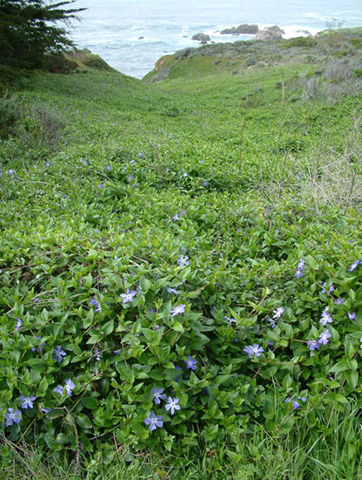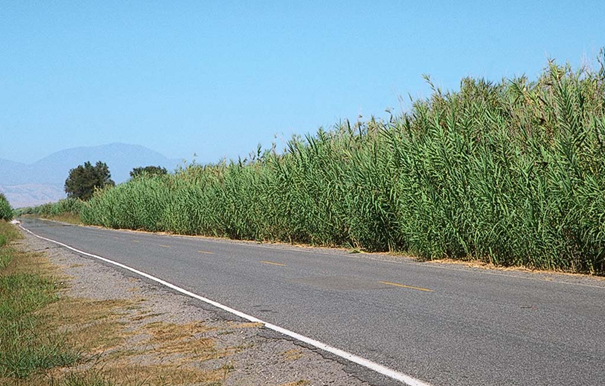Spring 2012: Managing Invasive Plants in Nurseries
Regional Report Ventura and Santa Barbara Counties by Julie P. Newman
The California Invasive Plant Council (Cal-IPC), a nonprofit organization, has created a useful inventory of invasive plants. Using a process based upon 13 criteria, they have listed about 200 species as threats to California’s wildlands. About 63% of these plant species were intentional introductions from all over the world. The majority of these intentionally introduced plant species came through the nursery industry as ornamental landscape plants and have escaped from gardens, such as periwinkle (fig. 1). However, some invasive plants, such as pampasgrass (Cortaderia selloana), were directly planted in natural areas for many years for erosion control.

Fig. 1. Periwinkle (Vinca major) is an example of an invasive plant species that has escaped from garden plantings to invade many coastal and riparian areas in California. In a 2003 survey of retail nurseries by Master Gardeners, it was available in 74% of the 92 nurseries surveyed. Photo by Bob Case. Source: www.cal-ipc.org.
The first step in managing invasive plants is to avoid contributing to the problem. Responsible nursery growers select plant species that minimize environmental liability issues, thus maintaining a positive public image of the industry through their environmental stewardship. Moreover, nurseries located in proximity to natural areas must be especially careful not to be a direct source of wildland invasions. Furthermore, the use of invasive plants on the nursery property in plant demonstrations and for esthetic purposes and environmental management (e.g., landscaping, screening, erosion management, vegetated buffers) should be avoided, especially when the property is located near or in natural areas.
So how do you know if your plant inventory includes invasive species? One resource is PlantRight, an alliance of leaders from the horticulture industry (including nurseries), scientists (including UC), environmental groups, and government agencies that works to reduce sales of invasive plants in the state. PlantRight’s website lists invasive plants by region of California with descriptions, photos and suggested plant alternatives. Similar information can be found in the popular brochure, Don’t plant a pest! found on the Cal-IPC’s website.
Another resource for local growers is our Master Gardener Program. A small group of Ventura County Master Gardeners have received training from PlantRight which has allowed them to survey Ventura County nurseries and provide information to nursery owners as part of a statewide UC Cooperative Extension effort to reduce the spread of invasive plant species. Survey results (specifically from retail nurseries) from the statewide project are available in an online UC IPM publication on invasive plants. Beginning in April, the Ventura County Master Gardener volunteers will restart the survey program. Following a review of nursery plant inventory they will be available to meet with the nursery owner/manager to provide suggestions for alternative noninvasive plants for any invasive species that they find. Retail and wholesale nurseries in Ventura County can schedule an appointment by calling our Master Gardener helpline at (805) 645-1455 or by email at mgventura@ucdavis.edu.
The Tenacious 21 — Ventura Country’s Top Problem Invasive Plants
- Arundo(Arundo donax)
- Tamarisk (Tamarix ramosissima)
- Perennial pepperweed (Lepidium latifolium)
- Spanish broom (Spartium junceum)
- Castor bean (Ricinus communis)
- Tree tobacco (Nicotiana glauca)
- Ice plant (Carpobrotus edulis)
- Pampas grass (Cortaderia jubata and Cortaderia selloana)
- Several Thistle varieties – Yellow star, Milk, Italian, Artichoke (Centaurea solstitialis L., Silybum marianum, Carduus pycnocephalus, Cynara cardunculus)
- Myoporum (Myoporum laetum)
- Vinca (Vinca major)
- Cape Ivy (Delairea odorata and Senecio mikanioides)
- Sweet Fennel (Foeniculum vulgare)
- Black Mustard (Hirschfeldia incana)
- Poison Hemlock (Conium maculatum)
- Tree of heaven (Ailanthus altissima)
- Pepper Tree (Schinus molle)
- Eucalyptus (Eucalyptus globulus var. globulus)
- Fan Palm (Washingtonia robusta)
Source: Ventura County Weed Management Area http://www.vcwma.org.
When unfamiliar weeds are found on the nursery property, the first step is proper identification. Our County website has a web page on local weeds and invasive plants that can assist you. You can search the database by scientific name or common name and flip through the photos to identify the plant. There are several photos of each plant representing different life stages.
Controlling plants such as arundo in natural areas of the nursery can be labor-intensive and costly and must be conducted in a manner that protects natural habitats (fig. 2). For example, in southern California, public agencies that manage or regulate rivers and streams restrict invasive plant control activities during spring to fall because threatened and endangered birds, such as the Least Bell’s Vireo or Southwestern Willow Flycatcher, nest during this period. There are often rare species of native plants that also need to be protected in many of these infested sites. In addition, herbicide sprays in stands mixed with native plants may not be allowed, and permits from multiple agencies may be required for removal of invasive species.

Fig. 2. Arundo (Arundo donax) is difficult to eradicate and threatens California’s riparian ecosystems by outcompeting native species. The Ventura County Resource Conservation District assists agriculture in control efforts and is developing a project to remove arundo and other non-native invasive plants in the Calleguas Creek Watershed. Photo by Joseph M. DiTomaso.
Ventura County nursery growers who need advice on controlling invasive species should contact the Ventura County Resource Conservation District/ Natural Resources Conservation Service office at (805) 386-4685. Growers can also refer to the Cal-IPC website for control recommendations in the Invasive Plants of California's Wildlands and in other resources listed on the Invasive Plant Management page.
Julie P Newman
Floriculture and Nursery Crops Advisor
UC Cooperative Extension Ventura County
669 County Square Drive, #100
Ventura, CA 93003-5401
(805) 645-1459 phone
(805) 645-1474 fax
jpnewman@ucdavis.edu
http://ceventura.ucdavis.edu












